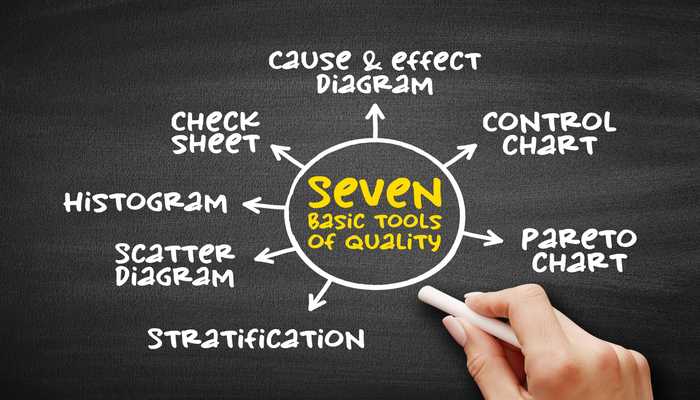Summary: Traditional quality control, which is based on test stations and manual inspection methods, is increasingly reaching its limits in complex and dynamic production environments: late fault detection, high rework costs, low data transparency. In worker self-inspection (WSI), the employees who manufacture or assemble the product also take direct responsibility for inspection, followed by digital documentation. The result: errors are detected early, corrections can be initiated immediately, and processes become leaner and more transparent. This article explains how digital solutions optimise worker self-inspection.
What is Worker Self-Inspection?
Unlike traditional quality assurance, worker self-inspection shifts responsibility for quality control directly to employees on the production line.
Key points of worker self-inspection:
➡️ Inspection according to clear standards: Quality controls are carried out according to guidelines and specifications that ensure that all products meet the same high standards.
➡️ Real-time error detection: Deviations in quality are detected directly during the production process, minimising rework and production delays.
➡️ Digital documentation: Quality inspection results are recorded directly in digital platforms such as real-time production systems, enabling transparent traceability and immediate analysis of the data.
➡️ Rapid corrective action: In the event of deviations, immediate measures are taken to quickly get production back on track and ensure quality.
Are manual inspections slowing you down?
flowdit empowers your workers to conduct self-inspections seamlessly
Traditional quality control vs. digital worker self-inspection
Traditional quality control often requires inspection stations where products are checked after manufacture to ensure they meet the required standards. These checks often take place at the end of the production process, which means that errors are detected late and corrections can only be made after production. The disadvantage of this method is the high cost and delay associated with correcting errors.
Digital worker self-inspection offers a significantly faster and more efficient solution. Using mobile devices and digital checklists, employees can identify and correct errors immediately during the manufacturing process. This leads to immediate error correction, reduces rework and ensures higher productivity and quality.
Comparison: Worker Self-Inspection vs. Traditional Quality Control
| Criterion | Worker Self-Inspection | Traditional Quality Control |
|---|---|---|
| Responsibility | Employees perform the inspections themselves | Quality managers or external auditors handle inspections |
| Inspection Frequency | Ongoing during the production process | Post-production (End of Line) |
| Process Integration | Integrated directly into the workflow | External, after production completion |
| Flexibility | Highly adaptable to production conditions | Standardized processes with limited flexibility |
| Costs | Lower costs by eliminating additional inspection stations | Higher costs from external quality control departments |
| Error Detection | Errors are detected quickly but often less precisely | Errors are detected systematically, but often delayed |
Advantages of Worker Self-Inspection
Worker self-inspection offers manufacturing companies numerous advantages that have a direct impact on daily production:
✅ Detect and correct errors early: When employees check their own results, errors are detected immediately and can be corrected straight away. This prevents subsequent production errors and continuously improves quality.
✅ Less rework, less waste: Errors that are corrected at an early stage prevent expensive rework and unnecessary waste. This saves material costs and reduces the effort required for rework.
✅ Cost reduction through fewer complaints: Since errors are detected immediately, this leads to higher-quality products and fewer complaints. For the company, this means not only lower costs, but also greater customer loyalty.
✅ Greater personal responsibility and motivation among employees: Direct responsibility for the quality of their own work increases employee motivation and commitment. They see the direct impact of their work and feel more connected to the company's goals.
✅ Optimisation and standardisation of processes: Clear templates and digital checklists not only create transparency, but also ensure standardised and efficient execution of inspections. This leads to more stable production and improves overall workflows.
5 Common Mistakes in Worker Self-Inspection
Five common mistakes that occur in practice are:
❗ Unclear inspection standards
Without precisely defined inspection requirements, misinterpretations can occur. Clear, standardised criteria are necessary to ensure that inspections are carried out consistently.
❗Inadequate training of employees
Mistakes in worker self-inspection often arise from a lack of training for inspectors. Regular training is necessary to ensure that all employees can perform the inspections correctly.
❗Lack of integration into quality management
If worker self-inspections are carried out in isolation from other quality processes, valuable insights remain unused. Integration into the overall QM system ensures comprehensive evaluation and continuous improvement.
❗Lack of feedback loops
Without structured feedback, employees do not learn from their inspections. A clear feedback process is crucial for identifying errors at an early stage and implementing improvements.
❗Overloading of inspectors
Too many tasks for one inspector lead to errors and negligence. A balanced distribution of work ensures that inspections are carried out in a focused and error-free manner.
Successfully Introducing Worker Self-Inspection: Practical Tips
The implementation of effective worker self-inspection contributes significantly to increasing efficiency and quality assurance in production. Clear steps are necessary to successfully establish the process.
1.) Plan a structured introduction
Start with careful planning of the introduction, clearly defining the goals and expectations of worker self-inspection. A step-by-step introduction helps to promote acceptance and minimise sources of error.
2. Use digital checklists
Use standardised checklists to systematically design inspection processes. These should be updated regularly to keep pace with production requirements and avoid errors.
3. Conduct regular training
Training should not be a one-off event, but should be ongoing. This ensures that all employees are always familiar with the latest quality standards and inspection requirements.
4. Feedback and process optimisation
Provide regular feedback and incorporate suggestions for improvement from employees. Continuous optimisation of inspection processes increases efficiency and strengthens commitment.
5. Use technologies
Integrate digital tools such as mobile apps and IoT technologies for documenting and analysing inspections. This facilitates tracking and contributes to long-term quality improvement.
How Digital Solutions are Transforming Worker Self-Inspection
In increasingly complex manufacturing processes, where every production run is prone to errors, the question often arises: How can we ensure that quality controls are carried out directly on site, without delay and with a high degree of accuracy? How can error detection and correction be integrated even more effectively to avoid unnecessary costs and time losses?
With flowdit, we offer you a solution that addresses these challenges:
✔️ Real-time error detection and immediate corrective action: Errors are identified directly during production and corrected immediately - without waiting times.
✔️ Automated, complete documentation: All checks are recorded digitally, ensuring complete traceability and transparent documentation.
✔️ Seamless integration into existing systems: flowdit can be easily integrated into your existing production and ERP systems without disrupting workflows.
✔️ Centralized data evaluation: Quality data is monitored in real time, enabling quick, informed decisions for process optimization.
✔️ Proactive notifications: Employees are immediately informed when deviations occur, so that problems can be rectified immediately.
✔️ Scalability and adaptability: flowdit is suitable for companies of all sizes and supports cross-location quality assurance.
Optimize Your Quality Assurance with flowdit
For Companies of All Sizes
flowdit enables efficient, cross-location quality assurance. Streamline your self-inspection processes, improve production quality, and reduce rework.
Are Your Production Processes as Responsive as They Could Be?
With flowdit, you can digitize your quality control and react to issues instantly.
See for Yourself!
Book a demo now and discover how flowdit can make your processes more efficient.
FAQ | Worker Self-Inspection
What exactly is ‘worker self-inspection’ and how does this approach differ from traditional end-of-line quality inspection?
Worker self-inspection means that employees independently check their work results during or after production. In contrast to traditional end-of-line quality inspection, which often takes place after production and is carried out by separate quality inspectors, worker self-inspection takes place directly at the workplace.
How can checklist software or a connected worker system efficiently support worker self-inspection?
Checklist software or a connected worker system supports worker self-inspection by automating and standardising the inspection process, which minimises the error rate. Employees receive clearly structured, interactive checklists on mobile devices that guide them through the necessary checks and provide immediate feedback.
How do you design a tactile and user-friendly digital checklist for worker self-checking so that it is accepted by employees?
A tactile and user-friendly digital checklist for worker self-checking should be intuitive, clear and optimised for mobile use. It must provide clear instructions, integrate seamlessly into the work process and provide real-time feedback and error messages. Close cooperation with employees in the design process and regular training promote acceptance and use of the system.
How can worker self-inspection reduce risks in the production process and improve operational safety?
Worker self-inspection reduces risks in the production process by enabling continuous error detection and correction during the production process. Early identification of deviations allows potential malfunctions or safety risks to be rectified in good time before they have a negative impact on production or safety. When combined with FMEA, this approach becomes even more effective, as FMEA helps prioritize critical failure modes, guiding workers to focus on the most important issues for early intervention and risk mitigation.
How can worker self-inspection be integrated into existing systems such as MES, ERP or CAQ?
Worker self-inspection is integrated into existing systems such as MES, ERP or CAQ using open interfaces (APIs) and standardised data formats. This allows test and inspection data to be transferred directly to the MES for production control, to the ERP for materials management or to the CAQ for quality control.
What digital data and key figures should be recorded in worker self-inspection in order to derive real improvements?
- Number of inspections carried out
- Frequency of deviations and errors
- Type and severity of errors
- Processing times per inspection step
- Corrective measures and their duration
- Repetition rates of errors
How can worker self-inspection be used as part of a continuous improvement process (CIP)?
Worker self-inspection can be used as part of a CIP by regularly evaluating data from inspections and using it as a basis for process optimisation. By integrating feedback mechanisms, such as regular team meetings or digital dashboards, employees can pass on their findings directly to those responsible. This makes it possible to identify recurring errors.
How can the return on investment (ROI) of worker self-inspection be measured?
To calculate the ROI accurately, the costs saved, e.g. reduced scrap rates and lower rework costs (avoided by identifying defects during the production process), are compared with the implementation costs of worker self-inspection (training, software, equipment).
How does worker self-inspection support internal and external audits in manufacturing companies?
Worker self-inspection ensures complete documentation and traceability of quality checks directly at the workplace. In audits according to ISO 9001 or IATF 16949, the inspection reports from worker self-inspection can serve as reliable evidence that quality standards are continuously being met.
Digital checklists and immediate error detection increase transparency and give the auditor access to real-time data.





